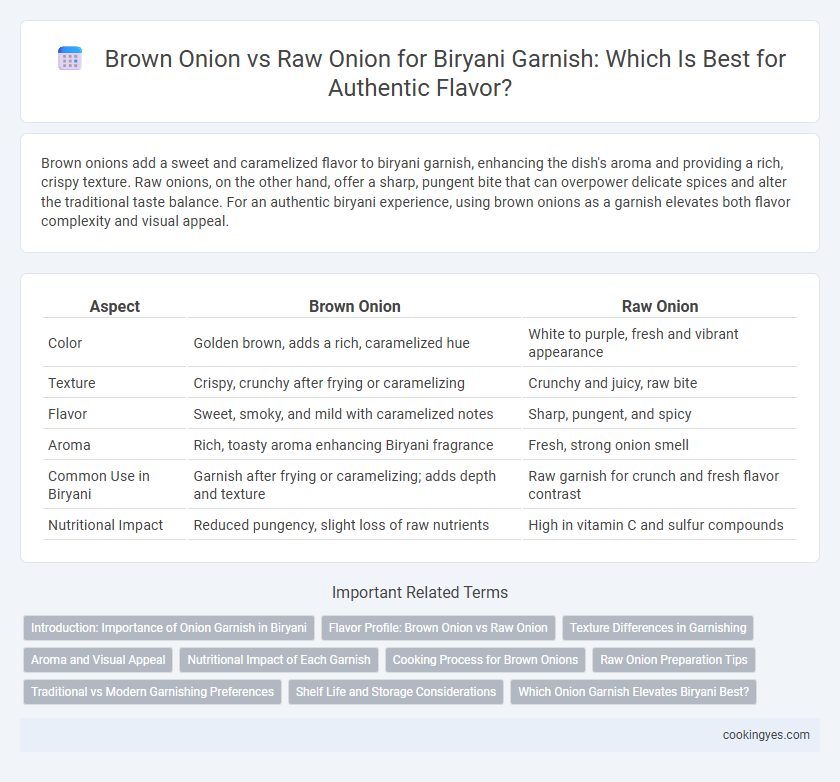Brown onions add a sweet and caramelized flavor to biryani garnish, enhancing the dish's aroma and providing a rich, crispy texture. Raw onions, on the other hand, offer a sharp, pungent bite that can overpower delicate spices and alter the traditional taste balance. For an authentic biryani experience, using brown onions as a garnish elevates both flavor complexity and visual appeal.
Table of Comparison
| Aspect | Brown Onion | Raw Onion |
|---|---|---|
| Color | Golden brown, adds a rich, caramelized hue | White to purple, fresh and vibrant appearance |
| Texture | Crispy, crunchy after frying or caramelizing | Crunchy and juicy, raw bite |
| Flavor | Sweet, smoky, and mild with caramelized notes | Sharp, pungent, and spicy |
| Aroma | Rich, toasty aroma enhancing Biryani fragrance | Fresh, strong onion smell |
| Common Use in Biryani | Garnish after frying or caramelizing; adds depth and texture | Raw garnish for crunch and fresh flavor contrast |
| Nutritional Impact | Reduced pungency, slight loss of raw nutrients | High in vitamin C and sulfur compounds |
Introduction: Importance of Onion Garnish in Biryani
Onion garnish plays a crucial role in enhancing the flavor and texture of biryani, with brown onions offering a caramelized sweetness that deepens the dish's complexity. Raw onions provide a sharp, crunchy contrast that brightens the palate and balances the rich spices. Selecting between brown and raw onions for garnish can significantly influence the overall sensory experience of biryani.
Flavor Profile: Brown Onion vs Raw Onion
Brown onions bring a sweet, caramelized depth to biryani garnishes, enhancing the dish with a rich umami flavor and subtle crunch. Raw onions offer a sharp, pungent bite that cuts through the spices, providing a fresh, crisp contrast to the rich rice and meat. Choosing between brown and raw onions depends on whether the desired flavor profile leans toward sweetness and savoriness or bright, piquant freshness.
Texture Differences in Garnishing
Brown onions offer a caramelized, crispy texture that adds a rich, sweet crunch as a garnish for biryani, enhancing both flavor and mouthfeel. Raw onions provide a sharp, crunchy bite with a fresh, pungent edge, offering a contrasting crispness that cuts through the spices. Choosing between brown and raw onions depends on the desired texture variation, with caramelized brown onions delivering softness and sweetness, while raw onions maintain their firm crispness.
Aroma and Visual Appeal
Brown onions caramelize to release a rich, sweet aroma that enhances the overall sensory experience of biryani, while their golden-brown color adds a visually appealing contrast to the dish. Raw onions, in contrast, provide a sharper, pungent scent that can overpower delicate spices and lack the warm tones that complement biryani's vibrant palette. Choosing caramelized brown onions as a garnish elevates both the fragrance and the visual presentation, making the dish more inviting and flavorful.
Nutritional Impact of Each Garnish
Brown onions used as a biryani garnish contain higher antioxidant levels due to the caramelization process, enhancing flavor complexity while providing modest increases in polyphenols. Raw onions retain more vitamin C and sulfur compounds, which contribute to immune support and anti-inflammatory benefits but offer a sharper taste. Choosing between brown and raw onion garnish affects both the nutrient profile and sensory experience of biryani, with caramelized brown onions favoring rich antioxidant intake and raw onions emphasizing vitamin and sulfur compound preservation.
Cooking Process for Brown Onions
Brown onions used for biryani garnish undergo a caramelization process that enhances their natural sweetness and deepens their flavor, creating a rich, golden-brown hue. This cooking process involves frying thinly sliced onions slowly over medium heat until they become soft, translucent, and develop a slightly crispy texture, which adds a complex, savory crunch to the biryani. Raw onions lack this depth of flavor and texture, making browned onions the preferred choice for an authentic, aromatic biryani finishing touch.
Raw Onion Preparation Tips
Raw onions enhance biryani's garnish with a crisp, pungent flavor that contrasts the rich spices, offering a refreshing bite. To prepare raw onions perfectly, slice them thinly and soak in cold water for 15 minutes to reduce sharpness and enhance crunchiness. Draining and patting them dry before garnishing ensures a balanced texture and prevents sogginess in the final dish.
Traditional vs Modern Garnishing Preferences
Brown onions, caramelized to a rich golden-brown, are traditionally preferred for biryani garnish in many regional recipes, adding depth of flavor and a sweet, slightly smoky aroma that complements the spiced rice and meat. Raw onions, thinly sliced and used in modern garnishing, provide a crisp texture and sharp pungency that contrasts with the savory biryani, appealing to contemporary palates seeking fresh, vibrant accompaniments. The choice between brown and raw onions reflects a broader shift from classic slow-cooked preparation methods to quicker, fresher garnishing trends in biryani presentation.
Shelf Life and Storage Considerations
Brown onions used for biryani garnish have a longer shelf life due to reduced moisture content and caramelization, which helps prevent spoilage and maintains crispness when stored properly in a cool, dry place. Raw onions, while offering a fresher, sharper flavor, have higher moisture content leading to quicker spoilage and require refrigeration to extend shelf life, typically lasting up to one week. For optimal biryani presentation and longevity, fried or caramelized brown onions are preferred over raw onions due to better storage stability and enhanced texture retention.
Which Onion Garnish Elevates Biryani Best?
Brown onions used as a garnish in biryani offer a rich, caramelized sweetness and crispy texture that enhances the dish's depth of flavor and visual appeal. Raw onions provide a sharp, pungent bite and crispness, contrasting the spiced, tender rice but can overpower the delicate balance of aromatic spices. For the best elevation of biryani, fried brown onions create a harmonious blend, adding sweetness and crunch that intensifies the overall taste experience.
Brown Onion vs Raw Onion for Biryani garnish Infographic

 cookingyes.com
cookingyes.com